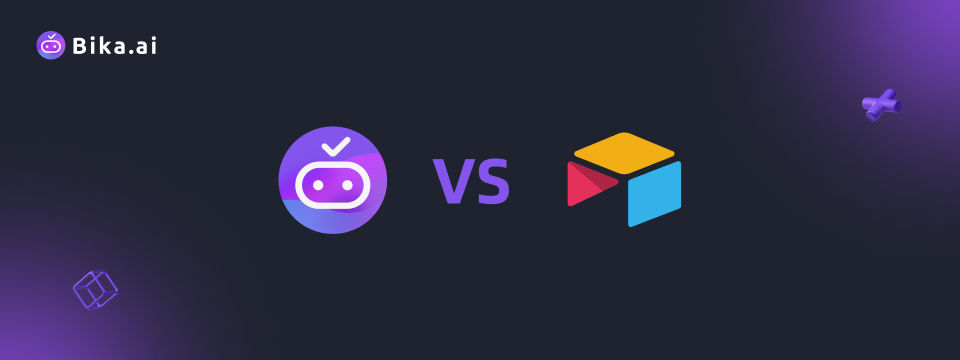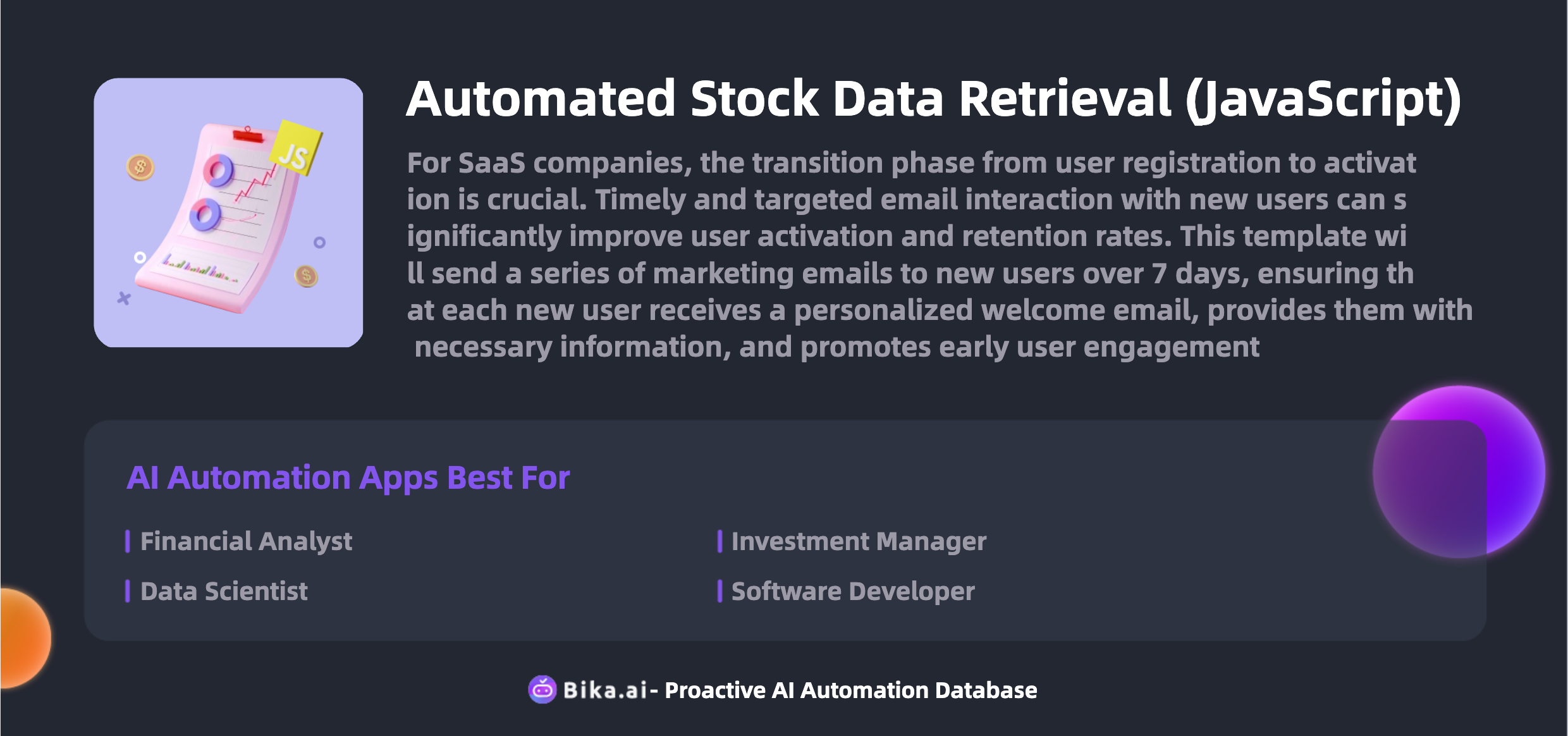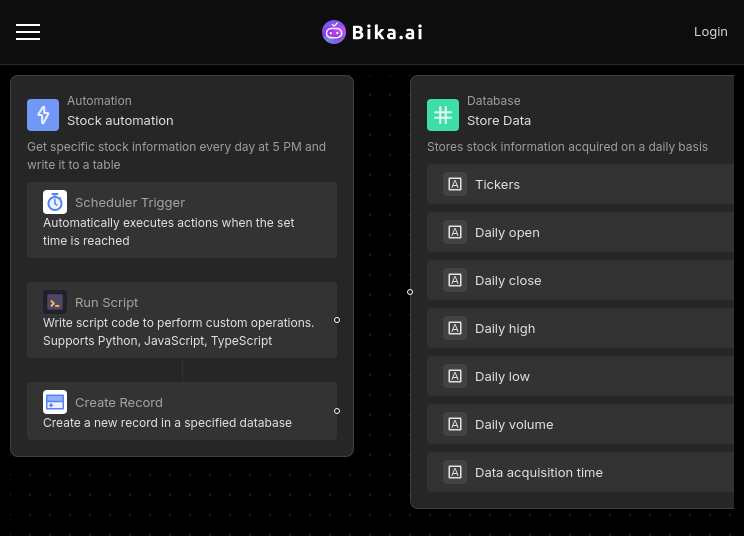
Airtable Pricing vs. Bika.ai Pricing: Which Offers Better Automation Value for Automated Stock Data Retrieval (JavaScript)?
What factors do you consider when choosing an automation tool?
When it comes to finding a tool that automates your business processes, you likely think first about whether the functionality meets your needs. However, it's undeniable that price is a crucial factor. Airtable is often considered for automation, but does its pricing align with your expectations? Especially when dealing with scenarios like Automated Stock Data Retrieval (JavaScript), comparing Airtable and Bika.ai in terms of pricing and functionality can help you make better decisions. It's important to note that Bika.ai's Automated Stock Data Retrieval (JavaScript) template is exceptionally well-suited for such scenarios. Free Trial

What are Airtable & Bika.ai?
Airtable is a cloud-based platform that combines the simplicity of a spreadsheet with the power of a database. It's designed for creating, sharing, and collaborating, allowing you to organize content, track projects, and manage tasks effectively. However, it has some challenges. The base structure can be complex for non-tech users, and it has limitations when handling large datasets and offering easy-to-use automation. The platform's architecture around "bases" can pose a steep learning curve, and it has restrictions on the number of records per base and the built-in automation capabilities.
Bika.ai, on the other hand, is a no-code AI automation database with an easy-to-use platform. It offers AI-Agent-enhanced CRM, marketing automation systems, project management systems, BI, and ERP at an attractive price. Bika.ai provides plug-and-play templates that simplify automating business processes, and it can handle large amounts of data effortlessly.
Airtable vs Bika.ai: Key Features At a Glance
Airtable is suitable for simple tasks and smaller databases. In contrast, Bika.ai can handle more complex tasks and larger data volumes, using AI automation to simplify various business activities. Here's a quick comparison of some key features:
| Feature | Airtable | Bika.ai |
|---|---|---|
| Pricing | Free provided, paid plans from $20/user/month | Free provided, paid plans from $9.99/user/month |
| Platform Type | No-code database | No-code AI automation database |
| Ease of Use | Base structure is geeky for non-tech users | Directory tree is easy to use and user-friendly for general users |
| Records per Database | Up to 125,000 records per base for Business plan | Up to 1,500,000 records per database for Team plan |
| Automation | Basic automation capabilities with limited triggers and actions | Advanced automation capabilities with extensive triggers and actions |
| Template | Templates don’t include automation capability; no automation publish and share | plenty of plug-and-play AI automated templates with preset content; supports automation publish and share |
| Storage | 100 GB of attachments per base | 800 GB per space |
| API | Limited APIs | API-first platform making every feature an integration endpoint for automation |
Pricing Comparison of Airtable vs Bika.ai
When comparing the pricing of Airtable and Bika.ai, it becomes clear that Bika.ai offers more value.
Airtable's pricing plans:
| Plan | Features | Price |
|---|---|---|
| Free plan | Unlimited bases 1,000 records per base Up to 5 editors 1 GB of attachments per base 100 automation runs Interface Designer | Free |
| Team plan | 50,000 records per base 25,000 automation runs 20 GB of attachments per base Standard sync integrations Extensions Gantt and timeline view Expanded color, formatting, and calendar options | $20 per user per month |
| Business plan | 125,000 records per base 100,000 automation runs 100 GB of attachments per base Premium sync integrations Verified data Two-way sync Admin panel SAML-based single sign-on | $45 per user per month |
| Enterprise plan | 500,000 records per base 500,000 automation runs 1,000 GB of attachments per base On-premises sync integrations Enterprise Hub Enhanced security and admin controls Enterprise API Extension and integration management Audit logs and DLP | Pricing on request (estimated to start at $70 up to $100 per user per month) |
Bika.ai's pricing plans:
| Plan | Features | Price |
|---|---|---|
| Free plan | 5GB of storage 10,000 records per database 200 automation runs Missions, Reports, AI Summary, and more Free Send Bulk 100+ SMS / 1000+ Email OpenAPI Access | Free |
| Plus plan | 50GB of storage 100,000 records per database 30,000 automation runs Permissions control More database fields, automation actions More free SMS, Email, Reports, Missions, AI | $9.99 per user per month |
| Pro plan | 200GB of storage 500,000 records per database 60,000 automation runs IM / Email Support Team / Organization Advanced OpenAPI and AI models | $19.99 per user per month |
| Team plan | 800GB of storage 1,500,000 records per database 100,000 automation runs Audit Logs Full integrations, automations Advanced Permissions | $39.99 per user per month |

Why Choose Bika.ai Over Airtable for Automated Stock Data Retrieval (JavaScript)?
If you're looking for an efficient tool for Automated Stock Data Retrieval (JavaScript), Bika.ai offers several advantages. It provides an intuitive UI layout that is easy for general users to navigate. It can handle up to 1.5 million records per database, ensuring seamless performance even with large amounts of data. Bika.ai's mission and workflow integrated AI automation capabilities significantly reduce manual tasks and increase productivity. The plug-and-play templates with preset content and the ability to publish and share them facilitate rapid implementation and collaboration within teams.
Specific examples of its value include:
- Daily stock performance tracking: Easily monitor the performance of stocks on a daily basis.
- Investment portfolio analysis: Analyze your investment portfolio to make informed decisions.
- Financial market research: Conduct in-depth research on the financial market.
- Automated stock trend analysis: Automatically analyze stock trends for better predictions.
- Real-time stock data monitoring: Stay updated with real-time stock data.
- Historical stock data comparison: Compare historical stock data to identify patterns.
- Data cleansing and preprocessing: Ensure the data is clean and ready for analysis.
- Predictive modeling: Build predictive models for future stock performance.
- Machine learning algorithm training: Train machine learning algorithms for more accurate predictions.
- Data visualization: Present data visually for better understanding.
- Trend analysis: Analyze trends to identify potential opportunities and risks.
- Correlation analysis: Understand the correlation between different stocks.
- Portfolio management: Manage your investment portfolio effectively.
- Risk assessment: Assess risks associated with your investments.
- Asset allocation: Optimize asset allocation for better returns.
- Performance benchmarking: Benchmark the performance of your investments.
- Investment strategy development: Develop effective investment strategies.
- Regulatory compliance: Ensure compliance with relevant regulations.
- API integration: Integrate with other systems through APIs.
- Automation script development: Develop custom automation scripts.
- Data pipeline creation: Create efficient data pipelines for data processing.
- Application development: Build applications based on the retrieved data.
- Performance optimization: Optimize the performance of your data retrieval and analysis processes.
- Error handling: Handle errors effectively to ensure data accuracy.
- Quantitative modeling: Build quantitative models for investment analysis.
- Statistical analysis: Perform statistical analysis on the stock data.
- Algorithmic trading: Implement algorithmic trading strategies.
- Backtesting strategies: Test trading strategies using historical data.
- Market risk analysis: Analyze market risks to make informed decisions.
- Signal generation: Generate signals for trading decisions.
- Portfolio rebalancing: Rebalance your portfolio as needed.
- Diversification strategies: Develop diversification strategies to reduce risks.
- Performance tracking: Track the performance of your investments over time.
- Client reporting: Generate reports for clients to keep them informed.
- Investment policy formulation: Formulate investment policies based on your goals.
- Long-term investment planning: Plan for long-term investments.

How to use Bika.ai's Automated Stock Data Retrieval (JavaScript) template?
Automatically fetches specific stock information on a daily basis and saves it to a table. This allows users to easily track and analyze stock trends, saving time and improving investment decisions.
The usage steps are as follows:
- Install the Template
Install this template into your Bika Space. If you need to manage multiple projects simultaneously, you can install this template multiple times. One template corresponds to one project.
- Get the API Key
This template uses the Alpha Vantage API to retrieve stock information. You need to apply for an API key on the Alpha Vantage website, which is free.
- Configure the Automation Task
Enter the Automatic Stock Data Retrieval automation task's edit interface, where you can modify the task's trigger conditions and execution actions. If not set, the default is to send reminders daily at 5 PM.
You can click on the trigger to set the reminder time under "Trigger Conditions."
During configuration, you need to replace the example __YOUR_API_KEY_HERE__ with the API key provided by Alpha Vantage. Additionally, you can adjust the stock ticker according to actual needs (the default is IBM).
- Test the Automation Task (Sending Stock Data)
We have enabled the Stock Data automation task by default. You can check if the reminder notification is successfully sent daily at 5 PM. You can also click "Run Now" to test if data is retrieved after configuring the API key and stock ticker.
- View Retrieved Stock Data
All retrieved stock information will be stored in the Stock Data database, where you can view and manage it at any time.
Conclusion: By using Bika.ai's Automated Stock Data Retrieval (JavaScript) template, you can efficiently handle stock data retrieval and analysis, making more informed investment decisions. It's time to take advantage of this powerful tool to solve your specific scenario challenges.

Recommend Reading
- Solve Duty Arrangement Challenges with Bika.ai's Rotating Duty Reminder(WeCom)
- Bika.ai vs Airtable: To Investment policy formulation
- Solve Invoice Detail Verification Challenges with Bika.ai's Automation Template
- Unleash Digital Marketing Potential with AI Batch Image Recognition
- Data Automation with Bika.ai: Unlocking New Potential for Marketing Teams with WeCom Scheduled Notifications
Recommend AI Automation Templates

Coming soon

Coming soon

Coming soon

Coming soon